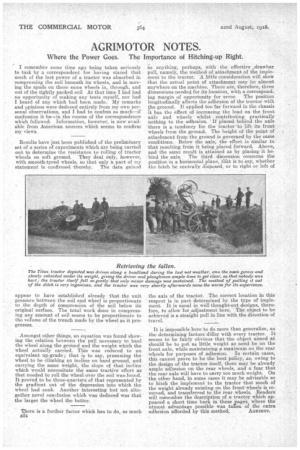AGRIMOTOR NOTES.
Page 14

If you've noticed an error in this article please click here to report it so we can fix it.
Where the Power Goes. The Importance of Hitching-up Right.
I remember some time ago being taken seriously to task by a correspondent for having stated that much of the lost power of a tractor was absorbed in compressing the soil beneath its wheels, and in moving the spuds on those same wheels in, through, and out of the tightly packed soil At that time I had had no opportunity of making any tests myself, nor had I heard of any which had been made. My remarks and opinions were deduced entirely from my own personal observations, and I had to confess as much—if confession it be-.-in the course of the correspondence which followed. Information, however, is now available from American sources which seems to confirm my views.
Results have just been published of the preliminary set of a series of experiments which are being carried out to determine the resistance to rolling of tractor wheels on soft ground. They deal only, however, with smooth-tyred wheels, so that only a part of my statement is confirmed thereby. The data gained appear to have established already that the unit pressure between the soil and wheel is proportionate to the depth of compression of the soil below its original surface. The total work done in compressing any amount of soil seems to be proportionate to the volume of the trench made by the wheel as it progresses.
Amongst other things, an equation was found showing the relation between the pull necessary to haul the wheel along the grOund and the weight which the wheel actually carried. This was reduced to an equivalent up-grade ; that is to say, presuming the wheel to be climbing an incline on hard ground, and carrying the same weight, the slope of that incline which would necessitate the same tractive effort as that needed to roll the wheel over the soil was.found. It proved to be three-quarters of that represented by the gradient out of the. depression into which the wheel had sunk. Another interesting but not altogether novel conclusion which was deduced was that the larger the wheel the better.
There is a further factor which has to do, as much a34 as anything, perhaps with the effective _drawbar pull, namely, the method of attachment of the implement to the tractor. A little consideration will show that the actual point of attachment may be almost anywhere on the machine. There are, therefore, three dimensions needed for its location, with a correspond_ ing margin of opportunity for error. The position longitudinally affects the adhesion of the tractor with he ground. If applied too far forward in the chassis it has the effect of increasing the load on the front axle and wheels whilst contributing practically nothing to the adhesion. 'If placed behind the axle there is a tendency for the tractor to lift its front wheels from the ground. The height of the point of attachment from the ground is governed by the same conditions. Below the axle, the effect is similar to that resulting from it being placed forward. Above, and the same result is attained as by placing it behind the axle. The third dimension concerns the _position in a horizontal plane, that is to say, whether the hitch be centrally disposed, or to right or left of the axis of the tractor. The correct location in this respect is in part determined by the type of implement. It is usual in well-thought-out designs, therefore, to allow for adjustment here. The object to be achieved is a straight pull in line with the direction of travel.
It is impossible here to do more than generalize, as the determining factors differ with every tractor. It seems to be fairly obvious that the object aimed at should be to put as little weight as need be on the front axle, while maintaining a maximum on the rear wheels for purposes of adhesion. In certain cases, this cannot prove to be the best policy, as, owing to the design .c)f the tractor itself, there may be already ample adhesion on the rear wheels, and a fear that the rear axle will have to carry too much weight. On the other hand, in some cases it may be advisable so to hitch the implement to the tractor that much of the weight already existing on the front wheels is removed, and transferred to the rear wheels. Readers will remember the description of a tractor which appeared a short time back in these _pages, where the utmost advantage possible was taRen of the extra adhesion afforded by this method. • AGRIMOT.






















